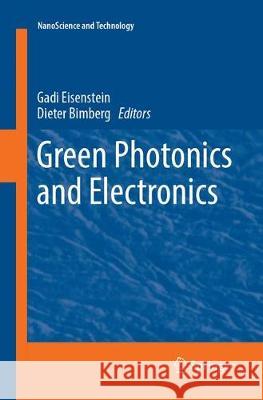Green Photonics and Electronics » książka



Green Photonics and Electronics
ISBN-13: 9783319883625 / Angielski / Miękka / 2018 / 291 str.
Green Photonics and Electronics
ISBN-13: 9783319883625 / Angielski / Miękka / 2018 / 291 str.
(netto: 461,12 VAT: 5%)
Najniższa cena z 30 dni: 462,63
ok. 22 dni roboczych
Bez gwarancji dostawy przed świętami
Darmowa dostawa!
List of Contributors
Markus C. Amann
Walter Schottky Institut
Technische Universität München
Germany
Dejan Arsenijević
Institut für Festkörperphysik
Technische Universität Berlin
Germany
Keren Bergman
Columbia University
USA
Dieter Bimberg
Institut für Festkörperphysik
Technische Universität Berlin
Germany
Sylvain Combrié
Thales Research and Technology
Palaiseau
France
John Clark
Finisar Corporation
Sunnyvale, CA
USA
Alfredo De Rossi
Thales Research and Technology
Palaiseau
France
Julie Sheridan Eng
Finisar Corporation
Sunnyvale, CA
USA
Alexander Fish
Bar-Ilan University
Israel
Eby G. Friedman
University of Rochester
USA
Chris Kocot
Finisar Corporation
Sunnyvale, CA
USA
Avinoam Kolodny
Technion
Israel
Karl Leo
Institut für Angewandte Photophysik
Technische Universität Dresden
Germany
Itimar Levi
Bar-Ilan University
Israel
James A. Lott
Institut für Festkörperphysik
Technische Universität Berlin
Germany
Philip Moser
Institut für Festkörperphysik
Technische Universität Berlin
Germany
Dessislava Nikolova
Columbia University
USA
Benjamin Oesen
Institut für Angewandte Photophysik
Technische Universität Dresden
Germany
Sébastien Rumley
Columbia University
USA
Payman Samadi
Columbia University
USA
Holger Schmeckebier
Institut für Festkörperphysik Technische Universität Berlin
Germany
Silvia Spiga, Walter Schottky Institut, Technische Universität München, Germany
Sascha Ullbrich
Institut für Angewandte Photophysik
Technische Universität Dresden
Germany
Inna Vaisband, University of Rochester
USA
Johannes Widmer
Institut für Angewandte Photophysik
Technische Universität Dresden
Germany
Gadi Eisenstein holds the Seiden chair in Optoelectronics and is the director of the Russel Berrie nanotechnology Institute at Technion. He received his PhD in 1980 from the University of Minnesota and then joined the AT&T Bell Laboratory Crawford Hill Research Laboratory where he worked for 10 years at the Photonic Circuits department before joining Technion in 1989. Professor Eisenstein was a guest professor at the University of Minnesota from 1997 till 1999. He was awarded the Alexander von Humboldt Award in 2007 at the Technical University Berlin where he has spent a sabbatical leave as guest Professor in 2011. In 2012 he was invited back to TU-Berlin as a return Humboldt Awardee. In 2012, he was elected Foreign Member at The Istituto Veneto di Scienze, Lettere ed Arti-a prestigious Venetian academy and in 2014, he received the William Streifer Award of the IEEE for seminal contributions to dynamics and noise properties of semiconductor lasers.
Dieter H. Bimberg received the Diploma in physics and the Ph.D. degree from Goethe University, Frankfurt, in 1968 and 1971, respectively. From 1972 to 1979 he held a Principal Scientist position at the Max Planck-Institute for Solid State Research in Grenoble/France and Stuttgart. In 1979 he was appointed as Professor of Electrical Engineering, Technical University of Aachen.
Since 1981 he holds the Chair of Applied Solid State Physics at Technical University of Berlin. He was elected in 1990 Excecutive Director of the Solid State Physics Institute at TU Berlin, a position he hold until 2011. Since 2004 he is director of the Center of Nanophotonics at TU Berlin. From 2006 -2011 he was the chairman of the board of the German Federal Government Centers of Excellence in Nanotechnologies.
His honors include the Russian State Prize in Science and Technology 2001, his election to the German Academy of Sciences Leopoldina in 2004, to the Russian Academy of Sciences in 2011 and to the US National Academy of Engineering in 2014, as Fellow of the American Physical Society and IEEE in 2004 and 2010, respectively, the Max-Born-Award and Medal 2006, awarded jointly by IoP and DPG, the William Streifer Award of the Photonics Society of IEEE in 2010, the UNESCO Nanoscience Medal 2012 and the Heinrich-Welker Award and Medal 2015. In 2015 he received a D. sc h. c. from the University of Lancaster.
His scientific work was leading to more than 1400 publications, more than 25 patents, and 6 books resulting in more than 40,000 citations worldwide and a Hirsch factor of 95.
His research interests include the growth and physics of nanostructures and nanophotonic devices, ultrahigh speed and energy efficient photonic devices for future datacom systems, single/entangled photon emitters for quantum cryptography and ultimate nanomemories based on quantum dots.
This books focuses on recent break-throughs in the development of a variety of photonic devices, serving distances ranging from mm to many km, together with their electronic counter-parts, e.g. the drivers for lasers, the amplifiers following the detectors and most important, the relevant advanced VLSI circuits. It explains that as a consequence of the increasing dominance of optical interconnects for high performance workstation clusters and supercomputers their complete design has to be revised. This book thus covers for the first time the whole variety of interdependent subjects contributing to green photonics and electronics, serving communication and energy harvesting. Alternative approaches to generate electric power using organic photovoltaic solar cells, inexpensive and again energy efficient in production are summarized.
In 2015, the use of the internet consumed 5-6% of the raw electricity production in developed countries. Power consumption increases rapidly and without some transformational change will use, by the middle of the next decade at the latest, the entire electricity production. This apocalyptic outlook led to a redirection of the focus of data center and HPC developers from just increasing bit rates and capacities to energy efficiency. The high speed interconnects are all based on photonic devices. These must and can be energy efficient but they operate in an electronic environment and therefore have to be considered in a wide scope that also requires low energy electronic devices, sophisticated circuit designs and clever architectures. The development of the next generation of high performance exaFLOP computers suffers from the same problem: Their energy consumption based on present device generations is essentially prohibitive.
1997-2025 DolnySlask.com Agencja Internetowa
KrainaKsiazek.PL - Księgarnia Internetowa









